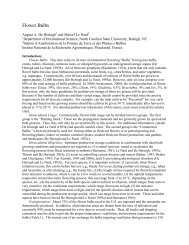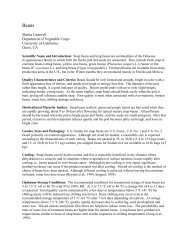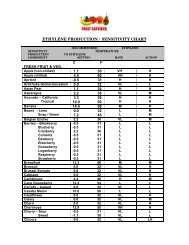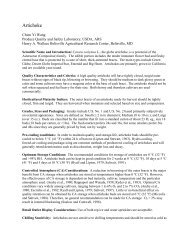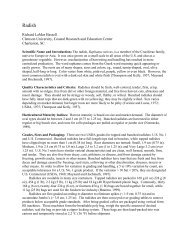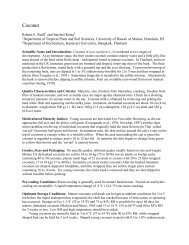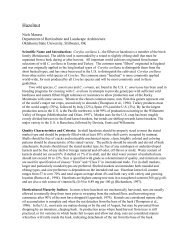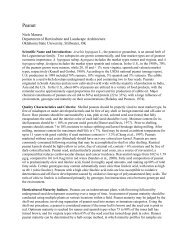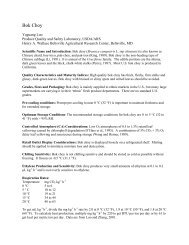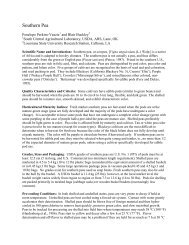Rambutan
Rambutan
Rambutan
You also want an ePaper? Increase the reach of your titles
YUMPU automatically turns print PDFs into web optimized ePapers that Google loves.
<strong>Rambutan</strong>Saichol Ketsa 1 and Robert E. Paull 21 Department of Horticulture, Kasetsart University, Bangkok, Thailand2 Department of Tropical Plant and Soil Sciences, University of Hawaii at Manoa, Honolulu, HIScientific Name and Introduction: <strong>Rambutan</strong> fruit (Nephelium lappacium L.) are large ovoid orglobose fruit about 4.5 cm (1.8 in) long and 2.5 to 3.7 cm (1 to 1.5 in) wide that occur on woody stalks inclusters of 10 to 18. The outer skin is 2 to 4 mm (0.1 to 0.2 in) thick and covered with soft, long spines(spinterns) that turn red or yellow when ripe. The edible aril flesh is attached to a single, large seed. Thefruit is related to litchi and longan (Nakasone and Paull, 1998).Quality Characteristics and Criteria: Quality criteria include: fruit size, shape, and weight; bright skinand spine color; uniformity; absence of defects; and freedom from disease and insects. High SSC and lowTA are desirable (Ketsa and Klaewkasetkorn, 1992). Mechanical injury and dehydration are major causesof appearance loss.Horticultural Maturity Indices: Skin and spine coloration is the main horticultural maturity index.Fruit having green skin and greenish-red spines are sour. Fruit have both skin and spines red or yellow,depending upon variety. Between these two stages, sugar content increases about 20%, and acid levelsare half that at the green stage (Mendoza et al., 1982). The acceptable stage is 16 to 28 days after colorbreak, at which time skin and spines are brightly colored (O’Hare, 1992). Over-ripe fruit have a waterytexture (Somboon, 1984) which may be a senescence-induced tissue breakdown.Grades, Sizes and Packaging: There are no U.S. or International grade standards. Fruit are sold in 2.25kg (5 lb) and 4.5 kg (10 lb), one-piece, fiberboard cartons. Sometimes fruit are pre-packed in punnets. InSoutheast Asia, clusters of fruit are sold in bunches still attached to the stemPre-cooling Conditions: Only room-cooling is recommended.Optimum Storage Conditions: Store at 8 to 15 °C (46 to 59 °F) with 90 to 95% RH to achieve astorage-life of 14 to 16 days. There may be changes in the skin and spine coloration after storage, but theflesh is unaffected. Temperature recommendations vary for different cultivars (O’Hare, 1992). Fruit heldat 20 °C (68 °F) with 60% RH last about 3 to 5 days.Controlled Atmospheres (CA) Consideration: CA of 7 to 12% CO 2 + 3 to 5% O 2 at 10 °C (50 °F) isrecommended (Kader, 1993). At 9 to 12% CO 2 color loss is reduced and shelf-life extended by 4 to 5days, while low O 2 (3%) has little affect (O’Hare et al., 1994; O’Hare, 1995). CO 2 levels >12% have noadditional effect, and decay can begin after a few weeks storage. The MA/CA effect appears to be morevia CO 2 elevation and minimizing water loss than through effect of low O 2 . Storage in sealedpolyethylene film bags or plastic containers is effective in reducing water loss (Mendoza et al., 1972;Ketsa and Klaewkasetkorn, 1995; Mohamed and Othman, 1988), while wax coatings are less effective(Mendoza et al., 1972; Brown and Wilson, 1988; Lam and Ng, 1982). A shelf-life of 14 to 21 days canbe expected.Retail Outlet Display Considerations: Display preferably in trays with a clear film over-wrap or inclam shell containers with no perforations at 10 to 12 °C (50 to 55 °F). Do not mist or ice.Chilling Sensitivity: If maintained at 5 °C (41 °F), fruit can be stored for up to 3 weeks, but the skin and
spines change from red to brownish-red; the edible aril is white and remains in good condition (Lam andNg, 1982). Somboon (1984) reported that after 3 days at 5 °C (41 °F), the aril turned from white(translucent) to being more transparent and juicier.Ethylene Production and Sensitivity: This non-climactic fruit has a very low rate of ethyleneproduction at < 0.04 µL kg -1 h -1 (O’Hare et al., 1994). Higher rates of up to 3 µL kg -1 h -1 can occur, ifthere is a fungal infection. The presence of 5 µL L -1 ethylene in CA (9 to 12% CO 2 ) or the presence of anethylene absorber does not influence rate of skin color loss (O’Hare, 1995).Respiration Rates: Respiration is 40 to 100 mg (about 23 to 57 µL) CO 2 kg -1 h -1 at 25 ºC (77 ºF).This is a non-climacteric fruit and the rates are for mature fruit; immature fruit respiration rates are higher(Mendoza et al., 1972). To calculate heat production, multiply mg kg -1 h -1 by 220 to get BTU per ton perday or by 61 to get kcal per metric ton per day.Physiological Disorders: Chilling injury and darkening of spines and skin are major postharvestdisorders. Darkening is due to dehydration and mechanical injury (Landrigan et al., 1996). Pre-harvestdisorders include skin splitting and poor filling of fruit (O’Hare, 1992). Skin splitting occurs in thinskinned cultivars often following heavy rains during the last phase of fruit growth. Poor filling has beenassociated with poor nutrition and dry conditions just after flowering.Postharvest Pathology: Postharvest losses due to disease are low (Ketsa and Klaewkasetkorn, 1992),though stem end rot and fruit rots are found. Sangchote et al. (1992) found that the spectrum of fungiassociated with rambutan decay varied with storage temperatures. Collectotrichum gloeosporioides andBotryodiplodia theobromae are considered the most serious pathogens. Other pathogens recorded includePestalotiopsis spp. and Phomopsis spp. (Farungasang et al., 1991).Quarantine Issues: <strong>Rambutan</strong> is a fruit fly host, and the available treatments are irradiation and heattreatment. Heat treatment leads to rapid loss of skin color. Mealy bugs are often found on the fruit, butno damage to the flesh occurs (Ketsa and Klaewkasetkorn, 1992).Suitability as Fresh-cut Product: Limited, since it is difficult to separate the aril and seed.Special Considerations: None.References:Brown, B.I. and P.R. Wilson. 1988. Exploratory study of postharvest treatments on rambutan (Nepheliumlappaceum) 1986/1987 season. Rare Fruit Counc Austral. Newsletter 48:16-18.Farungoang, U., N. Farungsang and S. Sangchote. 1991. Postharvest diseases of rambutan during storageat 13 or 25 °C. 8yh Austral. Plant Pathol. Soc. Congr., Sydney, Australia (abstract)Kader, A.A. 1993. Modified and controlled atmosphere storage of tropical fruits. In: B.R. Champ, E.Highley and G.I. Johnson (eds) Postharvest handling of tropical fruits. Proc. Intern. Confer. ChiangMai, Thailand, July 1993, ACIAR Pub. No. 50, pp 239-249.Ketsa, S. and O. Klaewkasetkorn. 1992. Postharvest quality and losses of ‘Rongrein’ rambutan fruits inwholesale markets. Acta Hort. 321:771-777.Ketsa, S. and O. Klaewkasetkoan. 1995. Effect of modified atmosphere on chilling injury and storage-lifeof rambutan. Acta Hort. 398:223-231.Lam, P.F. and K.H. Ng. 1982. Storage of waxed and unwaxed rambutan in perforated and sealedpolyethylene bags. MARDI Food Technol. Div. Rpt. No. 251, 23 pp.Landrigan, M., S.C. Morris, D. Eamus and W.B. McGlasson. 1996. Postharvest water relationships andtissue browning of rambutan fruits. Sci. Hort. 66:201-208.
Mendoza, D.B., E.B. Pantastico and F.B. Javier. 1972. Storage and handling of rambutan (Nepheliumlappaceum L.). The Philippines Agriculturist 55:322-332.Mendoza, D.B., P.T. Ramos, G.R. del Mundo, N.L. Garcia and G.G. Bantoc. 1982. Maturity and ripeningguide for rambutan cultivars. ASEAN-PHTRC Tech. Bull. No. 5. Univ. Philippines Los Banos.Mohamed, S. and E. Othman. 1988. Effect of packaging and modified atmosphere on the shelf- life oframbutan (Nephelium lappaceum). Pertanika 11:217-228.Nakasone, H.Y. and R.E. Paull. 1998. Tropical fruits. CAB Intl., Wallingford, U.K. 445 pp.O’Hare, T.J. 1992. <strong>Rambutan</strong>: Postharvest physiology and storage. Trop. Fruit News 26:4-6.O’Hare, T.J. 1995. Postharvest physiology and storage of rambutan. Postharv. Biol.Technol. 6:189-199.O’Hare, T.J., A. Prasad and A.W. Cooke. 1994. Low temperature and controlled atmosphere storage oframbutan. Postharv. Biol. Technol. 4:147-157.Sangchote, S.,U. Farungsang and N. Farungsang. 1992. <strong>Rambutan</strong> diseases. In: ACIAR Project 8844,Wkshp Postharv. Hand. Trop. Fruit, July 1992, Bangkok, Thailand. pp. 17.Somboon, Y. 1984. Effect of temperature and maturity stages on biochemical changes during storage oframbutan (Nephelium lappaceum Linn.) cv. Seechompoo and cv. Rongrien. M.S. Thesis. KasetsartUniv., Bangkok, Thailand, 64 pp. (in Thai)



